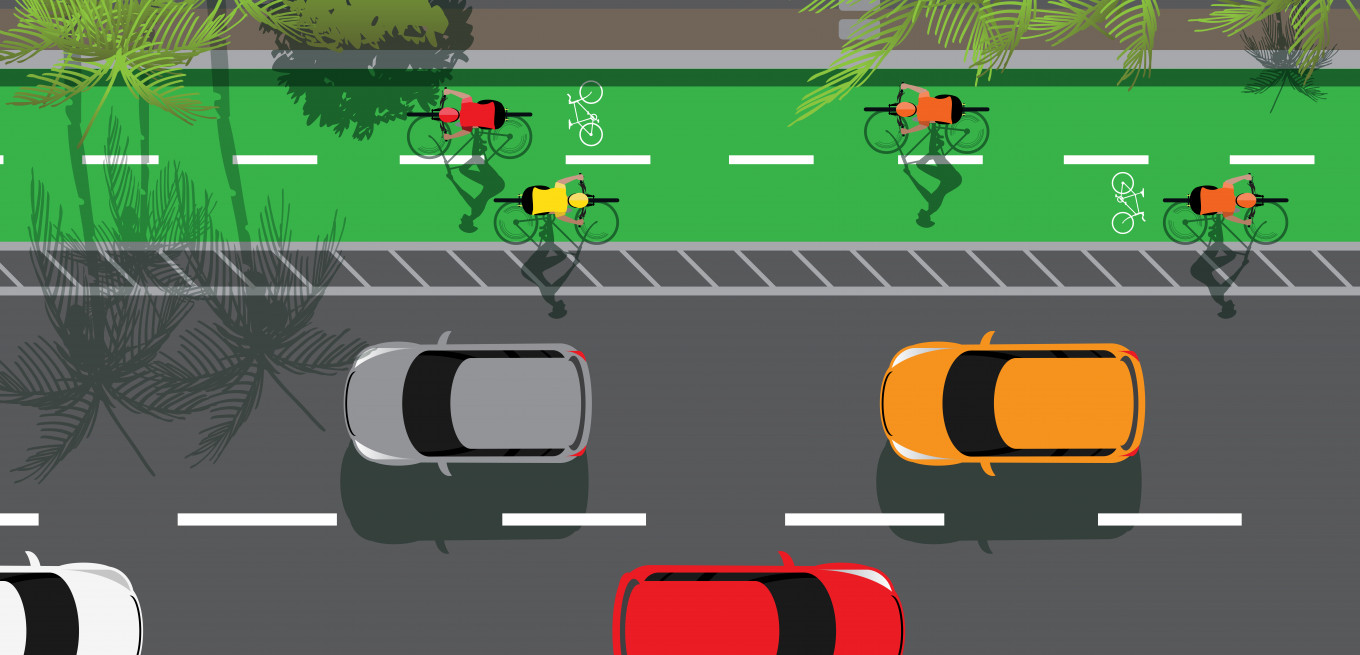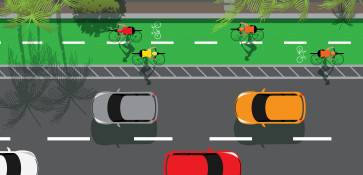Popular Reads
Top Results
Can't find what you're looking for?
View all search resultsPopular Reads
Top Results
Can't find what you're looking for?
View all search results
- -
- Fri, November 17, 2023
Change text size
Gift Premium Articles
to Anyone
Work It Right is a weekly column that provides practical and insightful advice on the complexities of urban transportation.
Painting the bicycle lane green is not considered part of bicycle infrastructure. Proper bicycle lanes must accompany proper planning that prioritizes safety and comfort for regular and prospective cyclists. Safe bicycle lanes will increase cycling confidence, leading to new cyclists, including children. A physical separator is vital to bicycle lane design, especially in a city like Jakarta.
Before we jump into whether the orange cone is a suitable separator for bicycle lanes, we should first understand how to design bicycle lanes. According to CROW-Fietsberaad, a cycling policy research institute, the design of bicycle lanes should prioritize pedal cycles, and it also states that bicycle lanes should accommodate the needs of regular cyclists, beginners and children. The width of bicycle lanes for child cyclists is significant, affecting the space reserved for adults accompanying children on their bikes. The design of bicycle lanes should consider five basic principles: safety, coherence, comfort, attractiveness and route continuity.
Designing a bicycle lane is not just about adding a lane and painting it green. It is important to note that adjustments must be made on a wall-to-wall scale when adding a bicycle lane to a road. The road design adjustment can take the form of narrowing the motor vehicle lane, creating crossing islands where cyclists wait and creating bicycle safety signs and extra traffic lights. Bicycle lane design variables also depend on motor vehicle volumes and speeds. These two variables will determine whether a separated or protected cycle lane is necessary. Based on the evaluation results of a bicycle lane design trial done by the Institute for Transportation and Development Policy (ITDP) in 2019, many violations occurred in the form of occupation of the bicycle lane by motorbikes and cars, parking vehicles, rickshaw idling and waiting for online motorcycle taxis.
In 2019, the ITDP monitored students' cycling in one of the state elementary schools in the Gandaria area of South Jakarta, where 10 percent of the students ride bikes to school. In the initial data collection, there were 40 students, ranging from the second to sixth grades, who cycled three to five times a week. Half of them cycled five times a week. The ITDP Indonesia then started collecting qualitative data by interviewing parents and students about cycling. The results were impressive; parents did not hesitate to allow their children to cycle, with their reasons for doing so ranging from independence to health. Although they do not allow their children to cycle outside the neighborhood, parents had high hopes in the bicycle lanes that were at the time being promoted by the Jakarta administration. The student cyclists also expressed their desire to cycle outside the neighborhood if the city were to build a protected bicycle lane on their route so the students could cycle freely and safely to the car-free-day area. “I would longer need to cycle at 4 a.m. to get to the car-free-day safely," one of the students said.
The ITDP's survey in 2022 showed that 80 percent of women respondents were highly confident about cycling in physically protected bike lanes. One of the biggest concerns for women is exposure to motorized vehicles, and this result aligns with that fact. It is also interesting to note that, although most women stated they are highly confident riding in bike lanes without protection, a significant difference was revealed when protective barriers are in place. Contrary to this, roads are often used by many female cyclists who ride without bike lanes. The survey implied that even small cycling infrastructure improvements, like markings for bike lanes, could be helpful for cyclists because it could raise motorists’ awareness of the cyclists’ presence.
In Jakarta, where almost every road is filled with motorized vehicles moving at high speeds, even on narrow roads, a high-quality bicycle lane separator is urgently needed. The orange cone is not a high-quality material, but it already “protects” the cyclist by minimizing accidents with motorized vehicles. If the city enhanced cyclist safety by replacing the stick cones, they should use permanent and durable materials such as concrete curbs, redesign junctions, adjust the locations of bus stops and enforce traffic laws strictly to enhance the quality of the bicycle lane system. The change to road studs marks an apparent deterioration in the quality of bicycle lane protection. Therefore, the clear intention of the removal is not to protect the cyclists nor to encourage more people to use the bicycle lanes.
-- Have a question about urban transportation? Email wir@thejakartapost.com with your name and current location (anonymous submissions will also be considered). Please note that The Jakarta Post reserves the right to edit your letters for publication.
***
The writer is a senior communications and partnership manager at the Institute for Transportation and Development Policy (ITDP).
Have a question about urban transportation? Send it to wir@thejakartapost.com with your name and current location (anonymous submissions will also be considered). Please note that The Jakarta Post reserves the right to edit your letters for publication.









